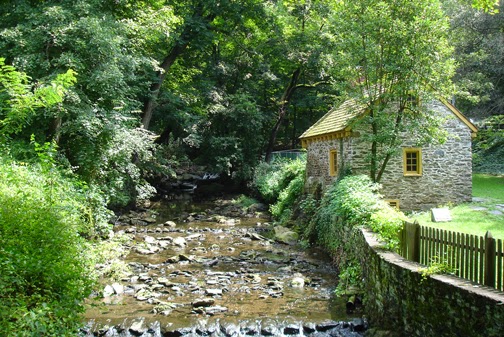Frank Strouse was my maternal GG Grandfather
I recently visited the Gettysburg battleground. Prior to getting deeply involved in genealogy, I vaguely knew that my maternal GG grandfather, Frank Strouse, served there but knew very little else. Other than telling one funny story, he did not talk to his family about the war. I took the opportunity of preparing for this Gettysburg trip to put more pieces together. Following is what I learned.
 |
| Pottsville ca 1861. John Warner Barber & Henry Howe,Our Whole Country or the Past and Present of the United States....Volume I (New York: Tuttle & McCauley, 1861), 538 |
Prior to the Civil
War, Pottsville had a longstanding National Light Infantry unit. When President
Lincoln issued a call to protect Washington, this unit was among the First
Responders. Frank Strouse was not among this initial unit, but at the end of their three
months tour of duty, when nearly all of the former National Light Brigade
members signed a three-year/duration of the war contract, Frank Strouse and
other Pottsville citizens joined them. They became Company A of the
newly authorized 96th Pennsylvania Infantry. Organized right in
Pottsville in September, 1861, the unit served in
many of the bloodiest fights of the war, finally mustering out after the Battle
of Cedar Creek in September, 1864.
Gettysburg
is only one of the many battles in which the 96th was engaged. When
I reviewed the service record for the unit, I could understand why he might
have chosen not to talk about what he must have witnessed and endured. Following
is a partial list of their campaigns and battles:
1862
First Battle of Manassas
Siege of Yorktown
Seven Days Battles before Richmond
Gaines' Mill
Maryland Campaign
Antietam
Battle of Fredericksburg
1863
Burnside's second Campaign, "Mud March"
Chancellorsville Campaign.
Maryes Heights, Fredericksburg
Battle of Gettysburg
Bristoe Campaign
Mine Run Campaign
1864
Rapidan Campaign
Battle of the Wilderness
Siege of Petersburg
Repulse of Early's attack
Sheridan's Shenandoah Valley Campaign
Battle of Opequan, Winchester
Battle of Cedar Creek
With specific
reference to Gettysburg, the 96th was part of the Sixth Corps
commanded by John Sedgwick. The rigorous march they made to Gettysburg earned
them the nickname “Sedgwick’s Foot Cavalry.” I had
believed that the 96th was held in reserve but that was not exactly
true, and certainly was not consistent with the position of their monument on
the field. A little more research revealed that when they reached the
battlefield the afternoon of July 2nd, Longstreet was in the process of driving
Sickles from his position. The men were at once formed, with no rest, to join
the battle and wound up to the right and front of Little Round Top. They took
position behind a stone fence and held the position with slight loss until end
of the battle.
The 96th
is commemorated with a monument of a prone soldier at the point where they were
positioned, and also with a plaque on the huge domed Pennsylvania State
Monument, which names every man who fought for Pennsylvania at Gettysburg.
 |
| Closeup of 96th Infantry plaque. Frank Strouse is a private in Company A. |
Frank
Strouse’s descendants can be proud of his service during the Civil War. We can also
count ourselves lucky that he survived the war to marry his sweetheart, Sarah
Jane Bast!
 |
| Memorial Stone at Highland Park Cemetery in Allentown |


















